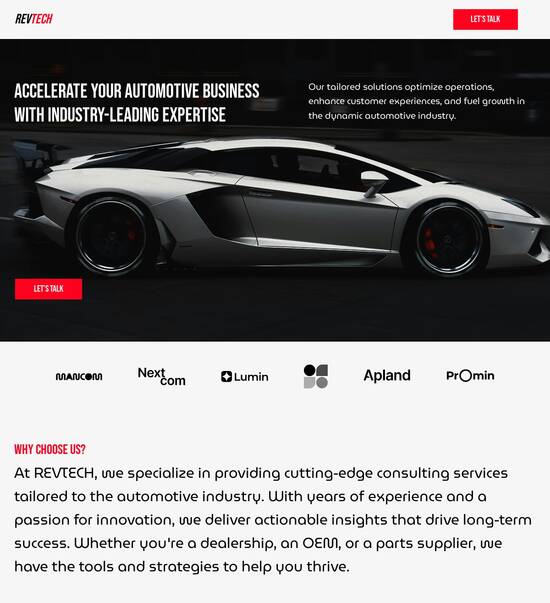
HTML page template with interactive product feedback form
Explore Similar TemplatesAbout template
Use HTML page templates with interactive product feedback form and make your communications easy and transparent. Try our solution today.
Recommended templates

Easy to build without coding
With the intuitive drag-and-drop builder, anyone on your team can create high-converting pages without any knowledge of code or design. Make enhancements to your landing page with custom widgets using Javascript, HTML/CSS, or third-party scripts.

Multiple layouts for any industry and goal
Select from 500+ landing page layouts built to boost conversions across industry-specific scenarios. Customize them by adjusting fonts, adding images, and generating on-brand content with the AI assistant. Quickly scale with Instablocks® and Global Blocks that you can save, reuse, and update globally.

Loads fast and looks polished on any device
Every template is responsive, which means they present professionally on any device and load blazingly fast with our Thor Render Engine. You can also power them up with Google AMP technology to deliver an unparalleled mobile experience and drive higher conversions.

Robust analytics & experimentation
Get real-time updates and reporting across all your devices, showing the number of visitors, conversions, cost-per-visitor, and cost-per-lead. Launch AI-powered experiments, run A/B tests, and use heatmaps to analyze user behavior, then optimize your landing page to maximize conversions.







Easy to build without coding
With the intuitive drag-and-drop builder, anyone on your team can create high-converting pages without any knowledge of code or design. Make enhancements to your landing page with custom widgets using Javascript, HTML/CSS, or third-party scripts.
Multiple layouts for any industry and goal
Select from 500+ landing page layouts built to boost conversions across industry-specific scenarios. Customize them by adjusting fonts, adding images, and generating on-brand content with the AI assistant. Quickly scale with Instablocks® and Global Blocks that you can save, reuse, and update globally.
Loads fast and looks polished on any device
Every template is responsive, which means they present professionally on any device and load blazingly fast with our Thor Render Engine.
Robust analytics & experimentation
Get real-time updates and reporting across all your devices, showing the number of visitors, conversions, cost-per-visitor, and cost-per-lead. Launch AI-powered experiments, run A/B tests, and use heatmaps to analyze user behavior, then optimize your landing page to maximize conversions.
All the features you need to build feedback form template html
Explore more featuresLearn how to build top-performing landing pages for any goal
FAQs
Leading the way in building high-performing landing pages





Unlocking the power of landing pages with Instapage
Instapage is creating a new standard in the world of landing pages and conversion rate optimization (CRO). Marketers across various industries—ranging from business services to education—are harnessing its capabilities to accelerate, optimize, and scale their digital marketing efforts effectively. In this guide, discover how to leverage Instapage’s robust features for creating high-converting landing pages, tailored specifically to maximize ROI.
Why use Instapage for your landing pages?
Instapage offers a comprehensive solution to build landing pages without needing extensive coding knowledge. With over 100 templates and lead generation elements accessible at your fingertips, creating compelling pages that convert is simple and efficient. Here are some advantages:
- 100+ high-converting templates: Instapage provides a diverse selection catering to different industries and conversion goals.
- No coding required: The intuitive drag-and-drop builder makes it easy for marketing teams of any size to create effective landing pages.
- Quick launches: Access templates and lead generation tools to generate landing pages rapidly.
Creating a high-converting landing page: Step one
Begin by selecting a template that resonates with your target audience. Instapage's library allows you to find layouts tailored to industries like financial services and tech. Choose a layout that aligns with your campaign’s goals and personalizes it to your brand.
Optimizing landing pages: Step two
After your landing page is published, optimization is key. Use the built-in A/B testing tools and detailed heatmaps to analyze user behavior on your pages. Understanding how users interact with your content helps you refine and improve your approach over time.
- Leverage A/B testing: Experiment with different headlines, images, or calls-to-action to determine what performs best.
- Utilize heatmaps: Gain insights into how visitors engage with your page, allowing for data-driven adjustments.
- Monitor analytics: Track key metrics such as conversion rates and user engagement to continuously enhance your strategy.
Personalizing your landing experience: Step three
Tailoring content to meet the specific expectations of your audience can dramatically increase conversions. Instapage enables you to deliver personalized experiences through dynamic text replacement and AdMaps, ensuring your marketing efforts are as targeted as possible.
- Dynamic text replacement: Modify content based on the keywords that brought users to your site.
- AdMaps: Align ads directly to the user’s experience on your landing pages, maximizing relevance.
- Audience tracking: Monitor how different segments interact with your pages, allowing for deeper insights into performance.
By following these steps and utilizing the powerful tools offered by Instapage, your marketing campaigns can achieve unprecedented levels of effectiveness.
Ready to transform your marketing strategy? Start using Instapage today and experience the difference it makes in generating high-quality leads and maximizing your return on investment.
People also ask about HTML page template with interactive product feedback form
HTML page template with interactive product feedback form
Understanding the power of HTML page templates
HTML templates serve as essential building blocks in web development. They allow developers to create reusable layouts that save time and effort during the design process. By using HTML templates, teams can streamline their workflow, whether they are constructing a simple webpage or a full-fledged web application.
The distinction between static and dynamic templates is crucial. Static templates display the same content regardless of user interaction, while dynamic templates can change content based on user inputs or other variables. This adaptability makes dynamic templates particularly useful for interactive applications, such as feedback forms.
HTML templates play a significant role in enhancing user experience. Utilizing a consistent format across different pages ensures that users can navigate easily, leading to an improved interaction with the site. Additionally, accessibility considerations must be made to cater to diverse user bases, ensuring that all visitors can engage with the content effectively.
The anatomy of an interactive product feedback form
An effective feedback form includes several key components designed to gather insightful responses. Input fields, such as text boxes, radio buttons, and checkboxes, provide various ways for users to share their thoughts. Each type serves distinct purposes—text boxes allow for detailed feedback, while radio buttons offer straightforward choices among defined options.
Incorporating rating scales further enhances respondent engagement. Instead of writing lengthy comments, users can simply provide a score, which can be analyzed easily for overall satisfaction. A comment section is equally important; it encourages detailed insights, allowing users to elaborate on their experiences in their own words.
User-centric design is paramount for feedback forms. Utilizing UX principles, such as clear labeling of form fields and logical layout, ensures that users can complete forms efficiently. Additionally, ensuring mobile responsiveness allows users to provide feedback via smartphones and tablets, broadening your audience significantly.
The benefits of integrating feedback forms
Integrating feedback forms into your web template fosters client engagement, creating a dialogue that benefits both the business and its customers. By actively seeking opinions, companies show that they value customer experiences, leading to increased trust and loyalty. Moreover, analyzing feedback trends can inform future marketing and product strategies.
Boosting the engagement rate is another significant advantage of interactive feedback forms. By providing intuitive interfaces that prompt user interaction, businesses can increase the frequency of responses. For example, a company might implement a feedback form with gamified elements that turn the process into an engaging activity, leading to higher completion rates.
Real-world case studies demonstrate the effectiveness of this approach. Companies that have adopted engaging feedback mechanisms have reported improved interaction metrics, showcasing the tangible benefits of integrating well-designed feedback forms into their marketing strategies.
Crafting the ideal feedback form template
To create an effective feedback form template, consider key features that cater to specific product needs. Customizable fields allow companies to tailor the form according to the nature of their offerings, while pre-built templates provide a jumping-off point for various industries. These adaptable options make it easy for marketers to implement feedback forms quickly.
Visual appeal is another critical factor in crafting feedback forms. Utilizing appealing colors, approachable fonts, and a clean layout can greatly impact user engagement. Interactive widgets, such as sliders or dropdowns, capture users' attention and encourage participation, holding their interest from start to finish.
Developing the setup procedure for your feedback form
Creating and implementing a feedback form involves a systematic approach. Begin by choosing the right HTML template, considering compatibility, design aesthetics, and responsiveness on various devices. A well-chosen template forms the foundation for user interaction and feedback collection.
Form field configuration: Align the provided input options with the specific feedback needs of your clients, ensuring clarity in what you ask them.
Integrating with existing site solutions: Use APIs to facilitate feedback submission and gathering, making the process seamless for users.
Testing for usability and accessibility: Conduct A/B tests to optimize the form's layout and performance, ensuring it meets diverse user needs.
By following these steps, businesses can roll out feedback forms that not only serve their primary purpose of data collection but also ensure a great user experience, fostering ongoing client relationships.
Leveraging feedback to drive purchase decisions
Utilizing client feedback effectively allows businesses to understand customer needs better. By forming a feedback loop, companies can enhance their product offerings and ensure they are addressing client concerns. For instance, consider Monica’s story, where actionable insights from customer feedback helped a business pivot its strategy, leading to improved product satisfaction.
Moreover, feedback data can be instrumental in boosting sales and cash flow. Analyzing trends offers insights into consumer behavior, allowing businesses to refine their marketing strategies. This alignment between product offerings and customer preferences will ultimately improve inventory management and drive revenue growth.
Exploring innovative features of feedback forms
Innovative feedback forms integrate interactive widgets that elevate user participation. Features such as sliders, drag-and-drop elements, and gamified questions transform the act of providing feedback into an engaging experience. These elements not only make the process enjoyable but also encourage more thorough feedback.
Real-time feedback analysis tools are equally essential. By connecting analytics to measure form effectiveness, businesses can track responses as they come in. This enables immediate adjustments based on what works best, ensuring constant improvement in engagement and response rates.
Maximizing the impact of feedback on user experience
Personalizing the client journey through feedback can significantly improve user experience. Techniques for tailoring products and services based on collected feedback strengthen customer relationships. For example, customizing follow-up communications based on user insights can create a more relevant and engaging experience.
Creating a culture of continuous improvement is also vital. Organizations should focus on establishing a feedback-rich environment where customer insights regularly inform product development. This emphasis on responsiveness fosters both customer loyalty and community-building efforts, leading to long-term success.
Best practices for maintaining an effective feedback loop
Regularly updating feedback forms is crucial for staying relevant in an ever-changing market. Establish a frequency for reviewing forms based on observed user trends. Keeping the content fresh not only encourages participation but signifies to clients that their opinions matter.
Encouraging ongoing client interaction is another key practice. After submitting feedback, implement strategies to keep clients engaged, whether through follow-up communications or surveys. Consider incentivizing feedback participation with rewards or promotions, creating a win-win scenario for both clients and businesses.
Real-world examples of successful implementation
Numerous companies have thrived through the integration of feedback into their business models. These organizations showcase the transformative power of feedback-driven innovation. Take, for example, a customer-centric tech company that made significant gains in user satisfaction by incorporating regular feedback sessions and iterative product adjustments.
Testimonials from satisfied customers highlight the effectiveness of interactive forms in enhancing their experience. These profiles serve as real-world evidence of the impact that well-implemented feedback mechanisms can have on a business’s trajectory.
Future trends in feedback collection technologies
As technology rapidly evolves, anticipated developments in HTML form design are likely to change how feedback is collected. Predictions lean toward increased integration of AI and machine learning, enhancing personalization and real-time analysis capabilities directly within feedback interfaces.
Client expectations are also shifting. As consumers become more tech-savvy, they seek more engaging and seamless feedback experiences. Feedback forms must evolve to meet these rising expectations, focusing on user experience and providing clear value in return for customer input.
Ready to skyrocket conversions?
Supercharge your ad campaigns with high-performing landing pages
Get started














